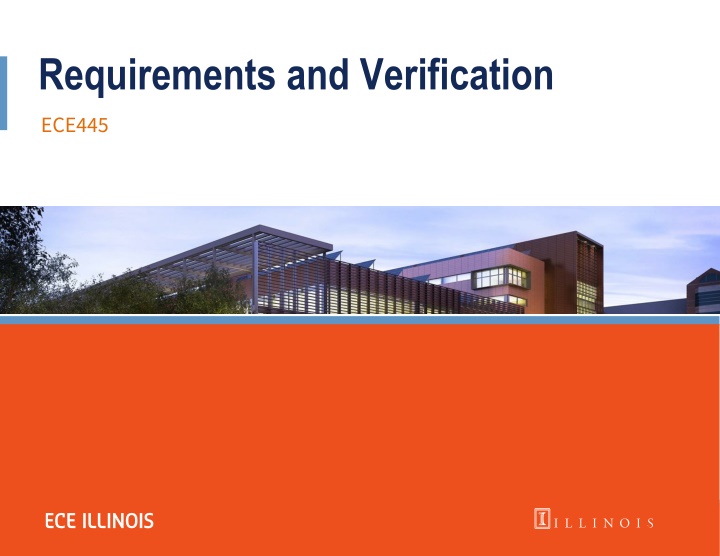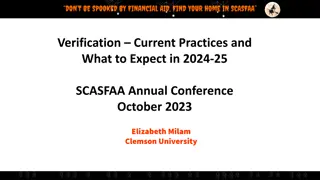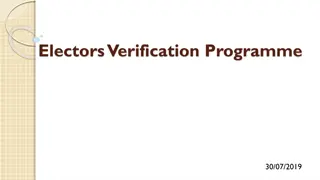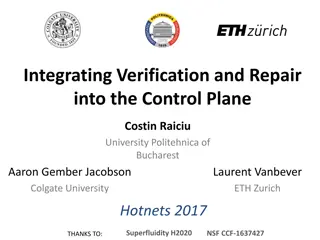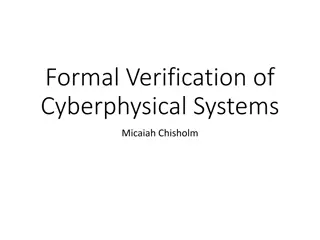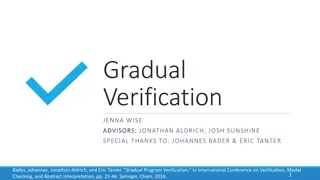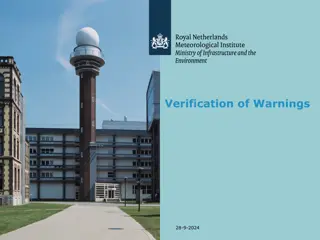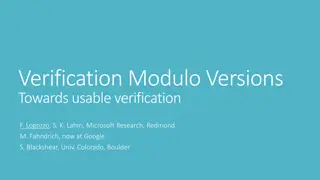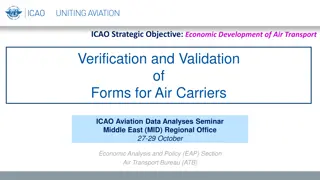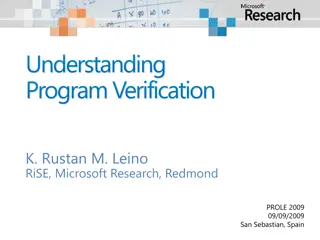Requirements and Verification
Dive into the essential aspects of requirements and verification in the context of ECE445. Explore the key concepts, processes, and techniques involved in ensuring the reliability and functionality of electronic systems. Understanding these critical steps is crucial for successful development and deployment in the field of Electrical and Computer Engineering.
Download Presentation

Please find below an Image/Link to download the presentation.
The content on the website is provided AS IS for your information and personal use only. It may not be sold, licensed, or shared on other websites without obtaining consent from the author.If you encounter any issues during the download, it is possible that the publisher has removed the file from their server.
You are allowed to download the files provided on this website for personal or commercial use, subject to the condition that they are used lawfully. All files are the property of their respective owners.
The content on the website is provided AS IS for your information and personal use only. It may not be sold, licensed, or shared on other websites without obtaining consent from the author.
E N D
Presentation Transcript
What is RV table? A two-column table with requirements on the left,and verificationon the right A checklist for both modular goals and modular debugging If all requirements have been verified byyour verificationfor every module, you should have a fully functioning project.
Requirements A technical definition of what each and every module in your system block diagram must be able to do Quantitative (tolerance range) Thorough and detailed Driven by project goals Design requirements purchase requirements
Verification A set ofproceduresthat you will use to verify that a requirement has been met Equipment Test procedures Presentation of results Explicit
Bad RV Example Voltage Regulator Requirements 1. Step down battery to 3.3VDC Verification 1. Take oscilloscope measurements to make sure that voltage output is 3.3V.
Bad RV Example Voltage Regulator Requirements 1. Step down battery to 3.3VDC Verification 1. Take oscilloscope measurements to make sure that voltage output is 3.3V. What is battery voltage?
Bad RV Example Voltage Regulator Requirements 1. Step down battery to 3.3VDC Verification 1. Take oscilloscope measurements to make sure that voltage output is 3.3V. Do I fail if the output is 3.25V?
Bad RV Example Voltage Regulator Requirements 1. Step down battery to 3.3VDC Verification 1. Take oscilloscope measurements to make sure that voltage output is 3.3V. Do we miss any requirements? e.g, current draw?
Bad RV Example Voltage Regulator Requirements 1. Step down battery to 3.3VDC Verification 1. Take oscilloscope measurements to make sure that voltage output is 3.3V. How to measure?
Good RV Example Voltage Regulator (adaptedfrom SP16WirelessIntraNetwork) Requirements 1. Provide 3.3V +/- 0.5% from a 3.7V-4.2V source 2. Can operate current within 0 - 300mA 3. Maintain thermal stability below 125 C Verification 1A. Measure the output voltage using an oscilloscope, ensuring that the output voltage stays within 5% of 3.3V. 2A. Connect the output of the voltage regulator to VDD node in the constant-current test circuit in Figure 3. 2B. Adjust Rs in Figure 3 to deliver at most 300mA to the load, measured by a multimeter. 2C. Measure the output voltage using an oscilloscope, ensuring that the output voltage stays within 5% of 3.3V. 3A. During verification for Requirement 1 and 2, use an IR thermometer to ensure the IC stays below 125 C.
Good RV Example Voltage Regulator (adaptedfrom SP16WirelessIntraNetwork) Requirements 1. Provide 3.3V +/- 0.5% from a 3.7V-4.2V source 2. Can operate current within 0-300mA 3. Maintain thermal stability below 125 C Verification 1A. Measure the output voltage using an oscilloscope, ensuring that the output voltage stays within 5% of 3.3V. 2A. Connect the output of the voltage regulator to VDD node in the constant-current test circuit in Figure 3. 2B. Adjust Rs in Figure 3 to deliver at most 300mA to the load, measured by a multimeter. 2C. Measure the output voltage using an oscilloscope, ensuring that the output voltage stays within 5% of 3.3V. Quantitative measurable ranges 3A. During verification for Requirement 1 and 2, use an IR thermometer to ensure the IC stays below 125 C.
Good RV Example Voltage Regulator (adaptedfrom SP16WirelessIntraNetwork) Requirements 1. Provide 3.3V +/- 0.5% from a 3.7V-4.2V source 2. Can operate current within 0-300mA 3. Maintain thermal stability below 125 C Verification 1A. Measure the output voltage using an oscilloscope, ensuring that the output voltage stays within 5% of 3.3V. 2A. Connect the output of the voltage regulator to VDD node in the constant-current test circuit in Figure 3. 2B. Adjust Rs in Figure 3 to deliver at most 300mA to the load, measured by a multimeter. 2C. Measure the output voltage using an oscilloscope, ensuring that the output voltage stays within 5% of 3.3V. Very detailed and thorough requirements 3A. During verification for Requirement 1 and 2, use an IR thermometer to ensure the IC stays below 125 C.
Good RV Example Voltage Regulator (adaptedfrom SP16WirelessIntraNetwork) Requirements 1. Provide 3.3V +/- 0.5% from a 3.7V-4.2V source 2. Can operate current within 0-300mA 3. Maintain thermal stability below 125 C Verification 1A. Measure the output voltage using an oscilloscope, ensuring that the output voltage stays within 5% of 3.3V. 2A. Connect the output of the voltage regulator to VDD node in the constant-current test circuit in Figure 3. 2B. Adjust Rs in Figure 3 to deliver at most 300mA to the load, measured by a multimeter. 2C. Measure the output voltage using an oscilloscope, ensuring that the output voltage stays within 5% of 3.3V. Step-by-step procedure 3A. During verification for Requirement 1 and 2, use an IR thermometer to ensure the IC stays below 125 C.
Good RV Example Voltage Regulator (adaptedfrom SP16WirelessIntraNetwork) Requirements 1. Provide 3.3V +/- 0.5% from a 3.7V-4.2V source 2. Can operate current within 0-300mA 3. Maintain thermal stability below 125 C Verification 1A. Measure the output voltage using an oscilloscope, ensuring that the output voltage stays within 5% of 3.3V. 2A. Connect the output of the voltage regulator to VDD node in the constant-current test circuit in Figure 3. 2B. Adjust Rs in Figure 3 to deliver at most 300mA to the load, measured by a multimeter. 2C. Measure the output voltage using an oscilloscope, ensuring that the output voltage stays within 5% of 3.3V. Equipment 3A. During verification for Requirement 1 and 2, use an IR thermometer to ensure the IC stays below 125 C.
Good RV Example Voltage Regulator (adaptedfrom SP16WirelessIntraNetwork) Requirements 1. Provide 3.3V +/- 0.5% from a 3.7V-4.2V source 2. Can operate current within 0-300mA 3. Maintain thermal stability below 125 C Verification 1A. Measure the output voltage using an oscilloscope, ensuring that the output voltage stays within 5% of 3.3V. 2A. Connect the output of the voltage regulator to VDD node in the constant-current test circuit in Figure 3. 2B. Adjust Rs in Figure 3 to deliver at most 300mA to the load, measured by a multimeter. 2C. Measure the output voltage using an oscilloscope, ensuring that the output voltage stays within 5% of 3.3V. Explicit set-up/configuration 3A. During verification for Requirement 1 and 2, use an IR thermometer to ensure the IC stays below 125 C.
Bad RV Example Personal Rain Detector It is raining; put on a jacket. Requirements 1. Raspberry Pi is functional. Verification 1A. Provide 5V power to Raspberry Pi. Inspect status lights to ensure it is operating. 2. Raspberry Pi GPIO pins can produce outputs. 2A. Toggle GPIO pins and measure with oscilloscope. 3. Speaker produces sound when powered. 3A. Drive speaker with 9V power supply and listen for sound to ensure it works. 4. Moisture sensor can survive manufacturer-specified weather conditions. 4. Put sensor outside on a rainy day and test that it works after.
Bad RV Example Personal Rain Detector It is raining; put on a jacket. Requirements 1. Raspberry Pi is functional. Verification 1A. Provide 5V power to Raspberry Pi. Inspect status lights to ensure it is operating. 2. Raspberry Pi GPIO pins can produce outputs. 2A. Toggle GPIO pins and measure with oscilloscope. 3. Speaker produces sound when powered. 3A. Drive speaker with 9V power supply and listen for sound to ensure it works. 4. Moisture sensor can survive manufacturer-specified weather conditions. ISSUE: Padding your RV table. Each of these is guaranteed by the manufacturer. You aren t testing any new designs of your own. 4. Put sensor outside on a rainy day and test that it works after.
